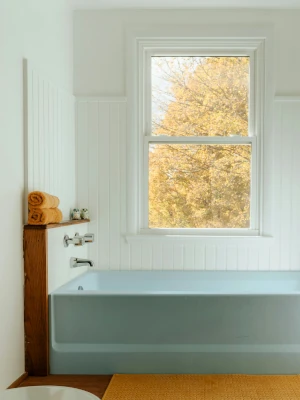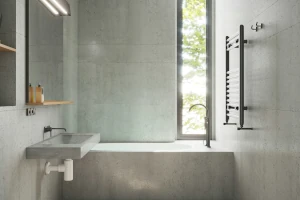Choosing the right tiles for your bathroom is one of the most important decisions in a bathroom remodel. Tiles set the tone for the entire space—they influence the style, enhance functionality, and tie together various design elements. Whether you’re renovating or starting from scratch, your tile choices will have a lasting impact on how your bathroom looks and feels.
The central point to this bathroom tile design guide is cohesion. Instead of picking tiles based on trends alone, it’s important to consider how they interact with your existing features, layout, lighting, and color scheme. With a thoughtful approach, you can create a space that’s both stylish and timeless.
Considering Existing Bathroom Elements
Fixtures
 Every bathroom starts with a set of fixed features—vanities, tubs, sinks, countertops, and hardware—that create the foundation of the room’s visual language. The tones and finishes of these elements help determine which tiles will feel natural in the space. Rather than trying to impose a new palette, work with what’s already present to create a layered, harmonious design. Look for undertones in materials—whether warm or cool—and use those as a guide when selecting tile color and finish.
Every bathroom starts with a set of fixed features—vanities, tubs, sinks, countertops, and hardware—that create the foundation of the room’s visual language. The tones and finishes of these elements help determine which tiles will feel natural in the space. Rather than trying to impose a new palette, work with what’s already present to create a layered, harmonious design. Look for undertones in materials—whether warm or cool—and use those as a guide when selecting tile color and finish.
Warm tones (e.g. wood, brass, beige): pair best with earthy tiles like sand, terracotta, or cream.
Cool tones (e.g. chrome, marble, blue): work well with slate, gray, navy, or white tiles.
Also consider the positioning of fixtures. For example, if your vanity is directly opposite the bathroom entrance, the wall behind it becomes a focal point—ideal for a feature tile or color accent. On the other hand, cluttered areas might call for more subdued, seamless tile choices to avoid visual overload.
Pay Attention to Natural Light

Light doesn’t just illuminate a space—it transforms how color, texture, and sheen are perceived. Natural light can reveal the subtle depth of a tile’s texture or make a bold color feel overpowering. Rooms with little to no natural light benefit from tiles that reflect and amplify light, while sunlit spaces can handle more varied finishes.
Low-light bathrooms: Favor glossy, light-toned tiles (white, pale gray, soft neutrals) to reflect light.
Bright bathrooms: You can experiment with matte finishes, deeper colors, or textured tiles.
Also, be mindful of light direction. A north-facing bathroom might cast cooler, blueish tones, while a south-facing one will make colors appear warmer.
Consider Room Size and Layout
 The size and shape of your bathroom affect how tile choices influence perception. Large tiles can open up a tight space, creating fewer grout lines and a more seamless appearance. In contrast, smaller tiles or bold patterns in a large bathroom can add a sense of detail and intimacy that prevents the space from feeling empty or sterile. Think about how your tile choices will interact with the room’s proportions—both in terms of function and aesthetic balance.
The size and shape of your bathroom affect how tile choices influence perception. Large tiles can open up a tight space, creating fewer grout lines and a more seamless appearance. In contrast, smaller tiles or bold patterns in a large bathroom can add a sense of detail and intimacy that prevents the space from feeling empty or sterile. Think about how your tile choices will interact with the room’s proportions—both in terms of function and aesthetic balance.
Small bathrooms: Use large-format tiles or continuous floor-to-wall tiling to create visual expansion.
Narrow bathrooms: Horizontal patterns, long rectangular tiles, or light tones can help widen the appearance.
If your bathroom has nooks, angles, or alcoves, consider using those architectural quirks to your advantage. A patterned tile can turn an awkward corner into a design feature, while uniform tiles across floor and wall surfaces can simplify a complex layout.
What Color/Mood Is Best?
Your tiles’ color can play dramatically into it’s mood, so it’s important to consider. Are you going for calm and spa-like, or bold and dramatic? Color plays a crucial role in setting that tone. Consider how different hues affect mood and how they fit into the overall aesthetic of your home.
White: Clean, open, timeless – ideal for any size bathroom, especially small or dim ones.
Gray: Subtle, elegant, grounding – works well in modern or minimalist spaces.
Blue: Cool, calming, serene – great for spa-style or coastal-inspired bathrooms.
Green: Refreshing, natural, tranquil – brings an organic, earthy feel.
Beige/tan: Warm, welcoming, traditional – complements rustic or classic interiors.
Black: Bold, dramatic, sophisticated – best used as contrast or in well-lit areas.
Yellow, orange, and red are bold, high-energy colors that can overwhelm a bathroom’s serene atmosphere, and are not listed above for that reason. They’re rarely used in tile design due to their intensity and limited versatility in something like a bathroom.
Choosing A Cohesive Color Palette

Choosing a cohesive color scheme for your bathroom tiles is key to creating a polished and unified design. Start by selecting a dominant color based on existing features or the mood you want to create. Then, build around it with complementary tones that support the overall feel without clashing or competing. Avoid using too many contrasting colors, as this can make the space feel too chaotic, which isn’t a great look for a bathroom.
 A practical rule is to limit your palette to two or three core colors:
A practical rule is to limit your palette to two or three core colors:
Primary color: The base tone used on most surfaces (walls, large tiles). It should make up approximately 60% of the room.
Secondary color: Supports the primary and adds depth (floor tile, cabinetry). It should make up approximately 30%
Accent color: Adds visual interest without overwhelming (mosaics, borders, decor). This should only be 10% of the room.
Try selecting a saturated accent, a duller secondary, and a white, gray or tan primary. Stick to either warm or cool tones within your palette and always test samples in the actual lighting of your bathroom before making final decisions. We offer samples in store you can take home to see how they look before making a final decision.
What Style of Tile is Best
Tile Color
 Tile color should reflect your overall bathroom palette and help tie the space together.
Tile color should reflect your overall bathroom palette and help tie the space together.
Floor tiles usually work best in a neutral or muted primary color, but may also go well with a secondary. Darker tones offer contrast but can make small spaces feel tighter.
Wall tiles are a good place for a secondary color or a lighter version of the floor tile. you may choose to include a secondary on one wall, with primary on the others A change in texture or sheen can add subtle contrast without changing color.
Shower tiles can be bolder. You may use richer tone or patterned tile on the back wall, but keep the palette consistent with the rest of the room. You may want to have the shower be a primary or secondary color if it takes up a large proportion of the room
Backsplash tiles are great for accents, slight color shifts, metallic finishes, or simple patterns. Be sure to coordinate with the vanity or fixtures to avoid harsh contrasts.
Grout color matters too. Matching grout blends in for a seamless look. Contrasting grout highlights tile shape but can be busier, especially in small areas.
Tile Size
 Tile size affects how open or crowded a bathroom feels. Large tiles (like 12″x24″) make rooms feel bigger by reducing grout lines. They’re great for floors and walls alike. Smaller tiles work best as accents—in backsplashes, shower niches, or borders. Too many small tiles, especially with high-contrast can look cluttered, especially in tight spaces.
Tile size affects how open or crowded a bathroom feels. Large tiles (like 12″x24″) make rooms feel bigger by reducing grout lines. They’re great for floors and walls alike. Smaller tiles work best as accents—in backsplashes, shower niches, or borders. Too many small tiles, especially with high-contrast can look cluttered, especially in tight spaces.
If mixing sizes, use a simple ratio—one tile should be half or one-third the size of the other. For example, 12″x24″ tiles pair well with 12″x12″ or 6″x6″. This will help make your bathroom more cohesive rather than chaotic. Limit yourself to two or three sizes total. Keep grout lines aligned and widths consistent for a clean finish.
Tile Shape
 Tile shape brings personality, but subtlety is key. Rectangular tiles (like subway style) are versatile and timeless—great for walls or floors. Square tiles offer symmetry and simplicity. Both are easy to coordinate.
Tile shape brings personality, but subtlety is key. Rectangular tiles (like subway style) are versatile and timeless—great for walls or floors. Square tiles offer symmetry and simplicity. Both are easy to coordinate.
To mix shapes, stick to just two. For example, pair rectangular wall tiles with small hex tiles on the floor, or square floor tiles with mosaic accents. Let one shape dominate, and use the other as an accent. Keep edges consistent—flat edges feel modern, beveled ones feel more tradition-al. Combining shapes works best when colors and finishes stay in sync. Keep it simple, and the room stays calm. Keep in mind, however, that floors should have a matte finish.
Practical Considerations for Tile
When choosing tiles, it’s important to consider durability and maintenance. Floor tiles should be rated for foot traffic and slip resistance, especially in wet areas. Porcelain is often more durable and water-resistant than ceramic, making it a better choice for floors and showers.
Cleaning and upkeep also matter. Glossy wall tiles are easier to wipe down, especially in areas exposed to water or soap. Matte or textured tiles may show less dirt but can be harder to clean. Grout should be sealed properly to prevent staining and mold, particularly in high-moisture areas like showers.
Installation is another key factor. Large tiles require a level subfloor and skilled installation to prevent lippage (uneven tile edges). Mosaic and small-format tiles need more grout and careful alignment, which can raise labor costs. Luckily we offer tile installation service to ensure even alignment.
Choosing the right bathroom tiles involves more than just picking colors or patterns—it’s about balancing style, function, and the room’s existing features. By considering elements like natural light, fixture placement, and overall size, you can make choices that enhance both the look and usability of the space. Cohesive color schemes, thoughtful size and shape combinations, and practical materials all contribute to a bathroom that feels intentional and well-designed.
From floor to backsplash, every tile decision should support the room’s flow and character. With careful planning and a clear vision, you can create a bathroom that feels cohesive, comfortable, and timeless.



